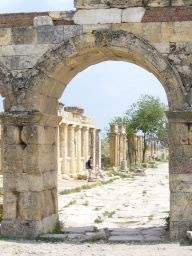
Pamukkale is one place in Turkey that I've always wanted to see. Earlier this month, Garry and I experienced this spectucular natural wonder for ourselves. Pamukkale was formed when warm, calcium saturated mineral water flowing down a cliff, progressively cooling and leaving brilliant white deposits in its wake. Over time a series of scalloped terraces and shallow pools, called travertines, formed along the cliff face, extending for more than a kilometre. The resulting effect is nothing short of breath-taking.

Known locally as the Cotton Castles, Pamukkale was every bit as memorable as I expected. It sits in the heart of Turkey looking out across a verdant plain of farms. The hillside dazzles in the sunlight, each travertine a blinding white and each pool of water a dusty blue, reflecting the sky above. The entire site appears as a pale white scar while still some distance away. Our tour guide pointed it out to us with more than half an hour before we reached the sight.

Surprisingly, tourists are still permitted to walk on sections of site. Garry and I naturally had to roll up our jeans and join the throng wading though milky pools. The surface under foot is gritty, at times the calcium is sharp and uncomfortable underfoot. As you descend the slowly forming travertines, the size and scale of this phenomeom progressively overwhelms you. It's easy to see why people have been venturing here since Roman times.

Along the hilltop sits the ruins of the a Roman spa town called Hierapolis. Founded around 190BC, the town became known for its curative mineral waters. A nearby hillside sports a spectacular Roman theatre, once capable of seating 12, 000 spectators. The town itself sports a stunning collonaded street, crowned by an almost unscathed triple processional archway.

Outside the town, quietly decaying tombs from a bygone Christian community, dot the countryside. Ailing folk once came from far and wide to seek a cure, only to pass away in their place of piligrimage. In places the calcium deposits have begun to reclaim the landscape leaving tombs part buried in sea of shimmering white shelves.


Perhaps the most novel sight at Pamukkale are the ancient baths. Garry and I gave them a go, along with hundreds of other visitors. Natural thermal pools have been converted into a wonderful bathing pools. However, unlike any other thermal venues, the floor of the pool is littered with fluted marble columns and submerged paving stones.
These are the last decaying remains of the original Roman baths. Sitting on one column, I truly felt a part of history. As I soaked up the warmth of water around me I could picture others doing exactly same thing 2000 years ago.




No comments:
Post a Comment